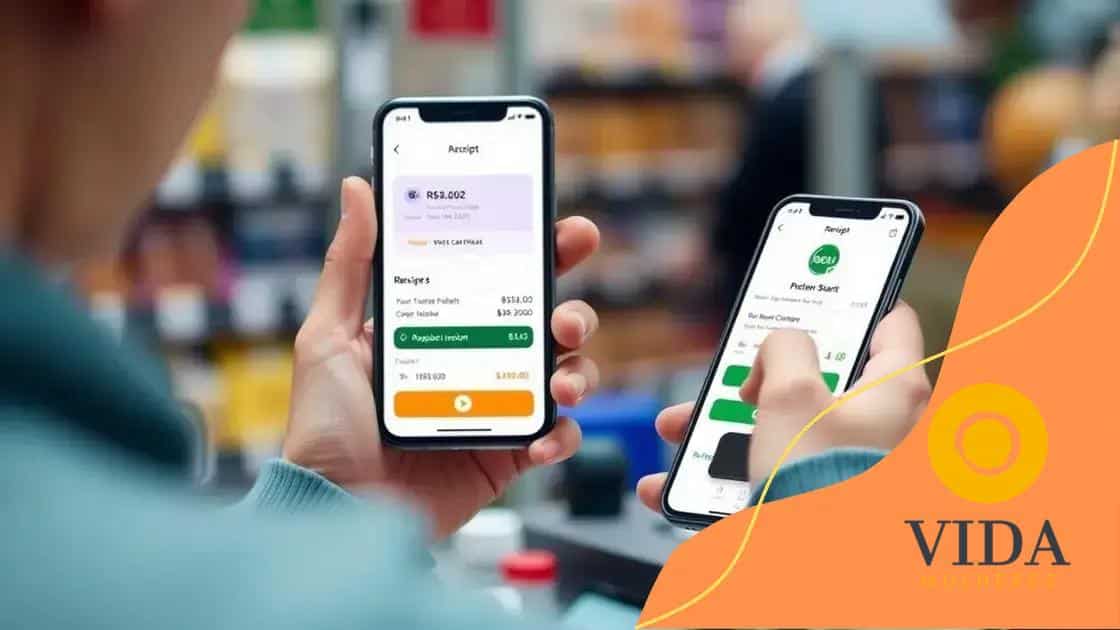Digital wallets tested for direct benefit disbursement

Digital wallets are online tools that streamline payments by securely storing users’ financial information, enabling quick transactions, enhancing security, and promoting the convenience of managing multiple payment methods all in one place.
Digital wallets tested for direct benefit disbursement are changing how we think about transactions.
Have you ever considered how these tools can simplify everyday payments while supporting those in need? In this article, we’ll dive into the exciting potential these wallets offer.
Understanding digital wallets in benefit disbursement
Understanding digital wallets in benefit disbursement is crucial in today’s rapidly changing financial landscape.
These wallets provide a convenient way for users to store and manage their funds digitally. With the advancement of technology, many governments and organizations are exploring how digital wallets can enhance the efficiency and accessibility of benefit disbursement.
Digital wallets serve as an electronic version of physical wallets, allowing users to hold money, make payments, and even receive funds directly.
They have become particularly relevant in programs aimed at assisting low-income households, making transactions smoother and more secure.
Core features of digital wallets
They come with numerous features that cater to different user needs:
- Instant Transactions: Users can send and receive funds in real-time, eliminating delays typically associated with traditional banking methods.
- Security Measures: Digital wallets often employ advanced encryption and authentication processes, providing enhanced security.
- Accessibility: They can be accessed via smartphones and computers, making it easy for users to manage their finances from anywhere.
- Integration with Services: Many digital wallets can seamlessly integrate with online services, making them versatile for various transactions.
This combination of features allows digital wallets to be an ideal solution for distributing benefits effectively. They not only streamline the process but also offer a user-friendly experience.
How digital wallets change benefit distribution
Another crucial aspect is how they facilitate payment distribution for benefits. Traditional methods can be cumbersome, often leading to delays and inefficiencies.
With digital wallets, beneficiaries receive funds directly, allowing them to use the money without waiting for checks or cash distributions.
For example, consider government assistance programs. By utilizing digital wallets, agencies can ensure that funds reach those who need them most promptly.
This system reduces administrative costs and minimizes the risk of fraud, ensuring that benefits are directed where they are intended.
The adoption of digital wallets also opens the door to valuable data collection. Agencies can analyze spending patterns, identifying how benefits are used by recipients.
This insight can lead to program improvements and more tailored support for individuals.
Benefits of digital wallets for direct payments

The benefits of digital wallets for direct payments are becoming increasingly evident as more people adopt this technology.
These wallets make transactions seamless and efficient, offering a range of advantages for users and businesses alike.
One of the primary benefits is speed. Digital wallets enable users to make payments instantly without the need for cash or checks.
This speed is especially advantageous in situations where quick transactions are essential, such as in retail environments or online shopping.
Key advantages of using digital wallets
There are several key advantages that digital wallets provide:
- Enhanced Security: Digital wallets employ advanced security measures, such as encryption and two-factor authentication, to protect user information.
- User Convenience: With digital wallets, users can store multiple cards in one place, eliminating the need to carry physical cards.
- Cost Savings: Many digital wallet services charge lower fees compared to traditional banking, saving users money on transactions.
- Rewards Programs: Some digital wallets offer rewards points or cash back on purchases, providing users with added incentives to use them.
This user-centric approach is transforming how people think about payments. For example, many people appreciate being able to complete their shopping with just a click or tap. No more fumbling for coins or worrying about carrying cash.
Moreover, digital wallets are particularly beneficial for businesses, as they can reduce transaction times and improve customer satisfaction.
By allowing customers to pay via digital wallets, businesses can streamline their operations and offer a more modern shopping experience.
As the use of digital wallets continues to grow, understanding their impact on direct payments becomes crucial.
The combination of convenience, security, and efficiency makes them an appealing option for both consumers and merchants.
Challenges in adopting digital wallets
While there are many benefits, there are also significant challenges in adopting digital wallets.
These hurdles can affect both users and businesses as they transition to this new financial technology. Understanding these challenges is essential for addressing them effectively.
One major issue is security concerns. Many users worry about the safety of their personal and financial information stored within digital wallets.
High-profile data breaches have made people cautious about using digital platforms for their transactions.
Key challenges to consider
There are several key challenges individuals and organizations may face:
- Insufficient Awareness: Many people are still unaware of how digital wallets work or their potential benefits. Education is crucial to encourage adoption.
- Technical Barriers: Some users may lack the necessary technology or internet access, limiting their ability to use digital wallets effectively.
- Compatibility Issues: Not all merchants accept digital wallets, creating frustration for users unable to make transactions where they shop.
- Regulatory Concerns: Different countries have varying regulations regarding digital financial solutions, creating operational challenges for wallet providers.
Addressing these issues requires a multi-faceted approach. For instance, enhancing security measures and providing transparency can help build trust among potential users.
Companies can also improve accessibility and integration with existing financial systems.
Engaging in community outreach to educate consumers about digital wallets will help demystify the technology.
Workshops or informational sessions can empower users to feel more confident in using digital wallets.
As the adoption of digital wallets continues to shift, overcoming these challenges is vital for ensuring broader acceptance and utility in everyday transactions.
Both users and providers must work together to create a safe, secure, and user-friendly environment.
Real-world examples of success
There are numerous real-world examples of success when it comes to the adoption of digital wallets.
These case studies illustrate how organizations and individuals have harnessed this technology to improve payment processes and enhance user experiences.
One notable example is the use of digital wallets in various government assistance programs.
Countries like India have implemented the Public Financial Management System (PFMS) to streamline direct benefit transfers. This allows funds to reach beneficiaries quickly and securely, reducing fraud and delays.
Successful implementations
Consider some specific cases where digital wallets have made a significant impact:
- Gojek in Indonesia: Gojek has successfully integrated a digital wallet into its ride-hailing platform. Users can pay for rides, food delivery, and other services seamlessly, boosting customer satisfaction.
- Venmo in the United States: Venmo has transformed the way people split payments among friends. Its ease of use and social features have made it a popular choice for quick transactions.
- WeChat Pay in China: This service is widely utilized for everything from shopping to paying bills. Its integration with social media has revolutionized payment experiences for millions.
- Paytm in India: Paytm has created a comprehensive ecosystem that allows users to pay bills, transfer money, and even access financial services like loans, showcasing the versatility of digital wallets.
These examples highlight the versatility and effectiveness of digital wallets across different regions and markets.
Users enjoy the conveniences these services provide, such as quick transactions and integrated lifestyles.
As digital wallets continue to evolve, observing how these successful implementations adapt and grow will inform potential improvements and innovations in payment solutions worldwide.
The growing trend reflects not just the technology itself, but the changing consumer behaviors that embrace quick, secure, and integrated financial transactions.
Future trends in digital payments
The future trends in digital payments are evolving rapidly as technology continues to influence our lives. Innovations in this space are reshaping how we conduct transactions and manage our finances with ease and security.
As more consumers embrace digital solutions, we see various trends emerging that could define the next era of payments.
One key trend is the increasing adoption of contactless payments. Using near-field communication (NFC) technology, people can make quick transactions by simply tapping their phone or card at checkout. This convenience appeals to those seeking faster, more efficient ways to pay.
Key future trends to watch
Here are some pivotal trends that are expected to shape the future of digital payments:
- Integration of Artificial Intelligence: AI is being used to enhance fraud detection, streamline user experiences, and personalize services. As AI technology advances, its application in digital payments will likely expand.
- Growth of Cryptocurrency: With increasing acceptance, cryptocurrencies may transform how we view money and transactions. More merchants are beginning to accept digital currencies as payment.
- Enhanced Security Features: As concerns over data breaches grow, future digital payment systems will likely incorporate advanced security measures such as biometric authentication and encryption to protect user information.
- Decentralized Finance (DeFi): This trend allows users to interact with financial services without traditional banks. DeFi platforms are gaining traction and could disrupt traditional banking systems.
These trends point towards a more interconnected and digital financial landscape. With each innovation, consumers can expect increased convenience and greater control over their payments.
Furthermore, the rise of mobile wallets signifies a shift in shopping behaviors. More people are shopping online and via mobile apps, making mobile wallets essential for providing a seamless shopping experience.
As we look ahead, the integration of these trends will redefine how consumers and businesses engage in financial transactions.
This evolution offers exciting possibilities that could enhance the way we think about payments and personal finance in the future.
FAQ – Frequently Asked Questions about Digital Wallets and Payments
What are digital wallets?
Digital wallets are online tools that allow users to store payment information and make transactions conveniently using their smartphones or computers.
How secure are digital wallets?
Digital wallets typically employ advanced security measures, such as encryption and two-factor authentication, to protect users’ financial information.
What are the benefits of using a digital wallet?
Benefits include quick and easy transactions, enhanced security, and the ability to store multiple payment methods in one place.
Are there any challenges in adopting digital wallets?
Yes, challenges include security concerns, a lack of awareness among users, and compatibility issues with certain merchants or services.






